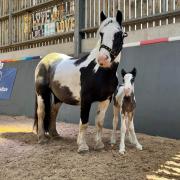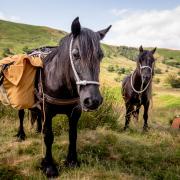A Lancashire artist and her poet husband have created a homage to Lancashire's most striking landmark. Karen Barden reports
Photoggraphy by Kirsty Thompson
Brian Fereday’s poetry
MarchWild March night tonightShe comes with foam flecked mouthtearing sand ribs,turning them liquid under her feet.March night with a south west galeSea-pies calling abovedriven from their muddy stancesresigned to the tidal cycleadvance and retreat.
TideGulls shimmer in call and featherThe tide is risingThey feel the energy and carry it into the air above.
(From) Moss RoadThere’s a raven crossing high before meComposed flight, even with this gale from the bay.Scorns the gleaming brotherhood below herOff to the fell where she holds a secret.
A mean wind whistles across the mystical sands, gulls and a pair of shelduck fly by, caught by shafts of spectacular light.
Watching on are a silent, striking couple, soaking up the scene. Where Morecambe Bay gives way to the Kent sands at its northern tip, a special bond has formed.
Award-winning artist Fiona Clucas and her countryman husband Brian Fereday are held captive by the estuary and its divine mudflat wildlife.They treasure its diversity, worry about its fragility and capture its beauty with paintbrush and Brian’s pen. The artist and poet’s perceptions are finely honed.
There is, they say, a harmful separation at play between humans and the natural world. And in a new exhibition – Shared Earth – they been trying to build bridges.
They have been exhibiting at Barwick Hall, Witherslack, near Grange-over-Sands, (it runs to July 1) and visitors have been admiring Fiona’s exquisite pictures, ably supported by Brian’s sharp, sensitive prose.‘We don’t want to preach,’ explains Brian, born and bred amid a glorious Kent Estuary countryside that has shaped his life.
‘This is about sharing the beauty. We just want people to stop, look around and wonder. If there is a message, it’s slow down and soak up what nature is giving us.’
Fiona’s early obsession with circuses, particularly Blackpool Tower, has been replaced by a fervour for the bay’s shifting sands, its transient light, unpredictable weather and most of all, its fauna and flora.
It was a move to the South Lakeland village of Witherslack, near the head of Morecambe Bay, which unleashed a passion in a frequently turbulent, often tranquil and always stunning seascape.
But the drama and diversity are nothing without the birds, fish, animals and plants which battle to survive in their rugged, harsh surroundings.‘For 17 years, I have been drawn to this magical place with its marsh, mosses, plants, animals and particularly the birds that inhabit these wild, watery spaces,’ explains Fiona.
‘I love the patterns and textures of sand and water and the constantly changing colours and hues. A bird or insect gives my paintings a focal point. The biodiversity is so very special; I want to reflect the uniqueness. Through our work, Brian and I aim to gently encourage people to take stock and care.’
Brian has spent most of his working life with the National Trust as a forester and warden, looking after tracts of land at Sizergh, near the estuary.
He is acutely aware there is not enough perception or appreciation of the countryside, its habitats and wildlife. His determination to share them became the inspiration for writing. ‘Hands-on work on the land has been my life,’ explains Brian. ‘As I get older, writing is something I can manage without more personal wear and tear.
‘I want to try to explain that there is no division between humans and nature; we’re all part of a cycle and separation isn’t built into it. We have a lack of sustainability; we ask far more of the land than it can give. Life is frantic and stress rife.
‘Sometimes, just sitting and watching is enough. We are part of the natural world and accepting it can bring inner peace and break the cycle of separation.’
Fiona is a deep-rooted Lancashire lass. Her grandfather ran Clucas Seeds of Ormskirk. Living on the Formby coast as a child gave her a strong affinity with the sea. Her father sailed, her mother painted and made pottery.
Animals have always been a major influence and as a fine arts student, she turned to the big top for inspiration.
‘My first visit was to Sir Robert Fossett’s Circus. There was so much to like, the atmosphere, excitement, lights and especially the animals.
‘They were well looked after, but I did feel sorry for the elephants, gentle, majestic creatures, manipulated by humans to stand on their back legs.’Fiona’s BA thesis was based on the circus. She worked and travelled with performers - once she’d convinced them she was not an animal rights’ activist.
One early summer morning in 1985, Fiona caught a bus to Blackpool and headed straight to the Tower Circus. Captivated by the sultan’s palace design, its turrets and plush red velvet, she wanted more.
‘I asked if there were any jobs going and I became an usherette for the rest of season. Taking a seedy bed-sit - with a skylight where I could watch the seagulls – I was able to sketch circus life from the royal box.‘During the Tory party bomb scare, we had to evacuate the building – with all the animals. Only the contortionist refused to move out!
‘Memorable times; elephants were exercised on the beach, until complaints put pay to the practise.
‘I had a crush on a horse-riding, ex-ballet dancer Hungarian juggler!’As Fiona interests and work expanded, so did recognition of an artist who has been reaping awards for over a decade. Last year, she received the Society of Wildlife Artists’ birdscape award in London.
Her paintings hang in Swedish state buildings, one is currently on tour in Europe, and they are increasingly sought by collectors.
All work sher has been showing in the Shared Earth exhibition is new. Several are from islands and Highlands of Scotland.
Fiona and Brian say they are not environmental evangelists, simply people who care.
Further information on Fiona’s work log onto www.fiona-clucas.co.uk


























